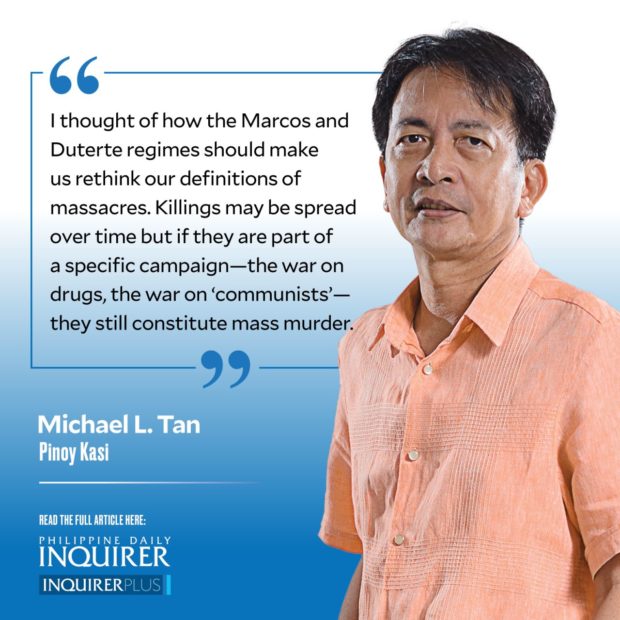I was surprised to find Wikipedia had an entry, “List of massacres in the Philippines,” dating back to the Spanish occupation, starting with several 17th-century massacres of Chinese. There was a “cholera massacre” when Filipinos turned on foreigners, suspecting they were spreading the deadly disease.
Into the 20th century, we find the first entry is the infamous Balangiga massacre in Eastern Samar, where American general Jacob Smith instructed his soldiers: “I want no prisoners … the more you kill and burn, the better it will please me. ” We only have estimates of the numbers killed, between 2,000 and 5,000.
The list of American massacres was sorely lacking such as the one at Bud Dajo during the first week of March, 116 years ago. About a thousand Moros who had climbed into the crater of the Bud Dajo volcano were massacred, provoking outrage even in the US.
Then World War II and the Japanese atrocities, and into our regained independence. The massacres continued, now pitting Filipinos against Filipinos.
The Marcos era saw several massacres, one of the earliest occurring during the Jabidah training camp where military officers massacred their own Muslim trainees and which sparked the secessionist movement, first by the Moro National Liberation Front.
During Noynoy Aquino’s presidency, there was Mamasapano, Maguindanao, on Jan. 25, 2015, with a botched operation where 44 members of the Philippine National Police Special Action Force were massacred.
Then a few entries under President Duterte, the last one being the massacre of nine farmers in Hacienda Nene, Sagay, Negros Occidental.
I thought of how the Marcos and Duterte regimes should make us rethink our definitions of massacres. Killings may be spread over time but if they are part of a specific campaign—the war on drugs, the war on “communists”—they still constitute mass murder.
The horrible statistics of deaths in these prolonged bloody campaigns are so large they numb you into insensitivity unless you get truly jolted by another angle on these narratives. An example is a short video, “Philippine drug war victims exhumed,” posted by South China Morning Post, showing the exhumation of the remains of two early victims of Mr. Duterte’s war on drugs, bones being removed because the victims’ families could not pay for a renewal of the lease, a mere P5,000 for five years.
I wondered how many of those early victims of the war on drugs are remembered by their families.
Surely though, I thought, we have to remember the more recent political assassinations. March 7 was the first anniversary of “Bloody Sunday 2021,” when the police and military launched simultaneous raids in Batangas, Cavite, Laguna, and Rizal, killing union leader Manny Asuncion, fisherfolk leaders Ariel Evangelista and Chai Lemita-Evangelista, housing rights activists Melvin Dasigao and Mark Lee Bacasno, Dumagat farmers Puroy and Randy dela Cruz, and banana farmers Edward and Abner Esto. One of the witnesses to the murder of the Evangelistas was their 10-year-old son.
Two days before Bloody Sunday, Mr. Duterte urged the police and the military that if they find rebels in an armed encounter, “Kill them, make sure you really kill them, and finish them off if they are alive.”
In December 2021, 17 policemen were charged with the murder of Asuncion, and a month later, another 17 policemen were charged for the killing of the Evangelista couple. In the latter case, the National Bureau of Investigation noted “deliberate intent to kill,” citing the police’s use of bonnets and their warning neighbors to close their windows and not to take any videos.
Cold executions, as seems to have been the case just last Feb. 24, with the New Bataan 5: the killing of “lumad” (indigenous peoples of Mindanao) volunteer teachers Chad Booc and Gelejurian Ngujo II, and three companions. Human rights groups dispute the military claim that there was an armed encounter. Only three days earlier, the military killed Kevin Castro, another volunteer teacher, in Polilio, Quezon.
A Filipino friend overseas texted me asking why a “dying regime” still resorts to these killings.
I texted back “the regime is not dying” adding that it had mutated into a two-headed monster out of the carcass of an old resurrected one. This monster is sending out strong signals through these new killings that they remain in power, and are intent on feeding their power with more blood if they win in the elections.
Murderous political despots actually know their history better than we forgiving and forgetful citizens.
